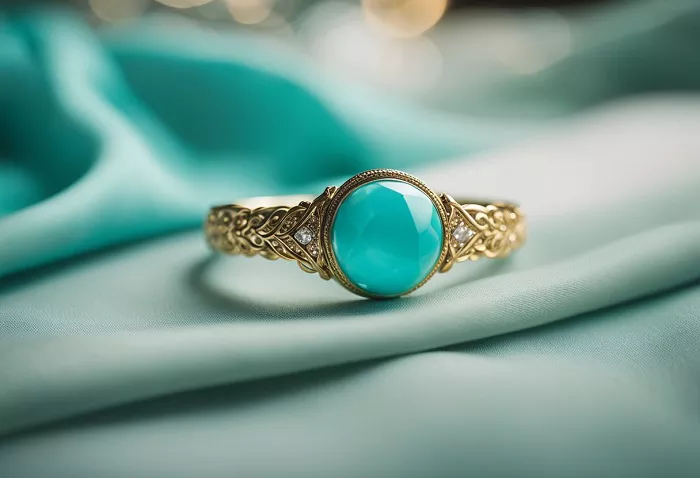Turquoise is one of the most beloved gemstones in the world. Its vibrant blue and green hues make it a favorite in jewelry. But many people wonder: Can anyone wear turquoise jewelry? The answer is yes—with some considerations.
This article will explore who can wear turquoise, how to choose the right piece, and the best ways to style it. We’ll also discuss cultural significance, skin tone compatibility, and care tips. By the end, you’ll know whether turquoise jewelry is right for you.
What is Turquoise?
Turquoise is a gemstone formed in dry, mineral-rich regions. It gets its color from copper (blue tones) and iron (green tones). The most prized turquoise comes from Iran, the Southwestern U.S., and Tibet.
This stone has been used for thousands of years. Ancient Egyptians, Native Americans, and Persians all valued turquoise for its beauty and spiritual meaning. Today, it remains popular in rings, necklaces, bracelets, and earrings.
Who Can Wear Turquoise Jewelry?
The short answer: Almost anyone! Turquoise suits most people, but some factors can influence how it looks and feels.
Skin Tone Considerations
Turquoise comes in different shades, from sky blue to deep green. Some colors look better on certain skin tones:
- Fair Skin: Light blue turquoise creates a soft, elegant contrast.
- Medium Skin: Both blue and green turquoise work well.
- Olive/Dark Skin: Bold green or deep blue turquoise stands out beautifully.
However, these are just guidelines. Personal preference matters most.
Personal Style
Turquoise fits many styles:
- Bohemian: Large, statement turquoise rings and necklaces.
- Classic: Simple turquoise studs or delicate pendants.
- Vintage: Antique turquoise pieces with intricate silverwork.
- Modern: Minimalist turquoise designs in sleek settings.
If you love bold colors, turquoise will suit you. If you prefer neutral tones, smaller turquoise accents may work better.
Cultural and Spiritual Beliefs
Some cultures associate turquoise with protection and healing. Native American traditions, for example, consider it sacred. If you respect these beliefs, wearing turquoise can feel meaningful.
However, some people avoid turquoise due to personal or cultural reasons. Always wear it with respect if it holds significance in certain traditions.
Benefits of Wearing Turquoise Jewelry
Turquoise isn’t just pretty—it has many benefits:
Emotional Balance
Many believe turquoise calms emotions. It’s said to reduce stress and promote inner peace.
Physical Healing
Some traditions claim turquoise helps with throat and lung health. While not scientifically proven, many wear it for its soothing energy.
Protection
Ancient cultures believed turquoise guarded against negative energy. Some still wear it as a protective charm.
Fashion Versatility
Turquoise matches many colors—white, black, brown, and even bright shades like red or yellow. It’s perfect for any season.
How to Choose the Right Turquoise Jewelry
Not all turquoise jewelry is the same. Here’s how to pick the best piece:
Natural vs. Treated Turquoise
- Natural Turquoise: Rare and valuable. It has slight imperfections but is more durable.
- Stabilized Turquoise: Treated to enhance color and hardness. Common in affordable jewelry.
- Reconstituted Turquoise: Made from turquoise powder. Less valuable but still attractive.
For long-lasting jewelry, choose natural or stabilized turquoise.
Metal Pairings
Turquoise looks best with certain metals:
- Silver: A classic choice, especially in Southwestern styles.
- Gold: Adds luxury, making turquoise look richer.
- Copper: Enhances the stone’s earthy vibe.
Pick a metal that suits your style and skin tone.
Setting and Design
- Bezel Setting: Protects the stone from damage (great for rings).
- Prong Setting: Shows more of the stone but is less secure.
- Wire-Wrapped: Handmade, boho-style jewelry.
Choose a setting based on durability and aesthetics.
When Should You Avoid Turquoise Jewelry?
While most people can wear turquoise, some situations call for caution:
Allergies or Sensitivities
Some turquoise is treated with dyes or resins. If you have sensitive skin, opt for natural, untreated stones.
Harsh Environments
Turquoise is softer than diamonds or sapphires. Avoid wearing it during heavy work, swimming, or sports.
Cultural Appropriation Concerns
If wearing Native American-style turquoise, buy from authentic Native artists to support their craft. Avoid mass-produced imitations.
How to Care for Turquoise Jewelry
Turquoise needs gentle care:
Avoid water and chemicals (perfume, lotion, chlorine).
Store separately to prevent scratches.
Clean with a soft cloth—no harsh cleaners.
Recharge in moonlight (if you believe in its spiritual properties).
Conclusion
Yes! Turquoise jewelry suits almost everyone. It works for all skin tones, styles, and occasions. Just choose the right shade, setting, and quality for your needs.
Whether you wear it for fashion, healing, or tradition, turquoise is a timeless gem. With proper care, it can last for generations. So, if you love its vibrant hues, don’t hesitate—turquoise jewelry is for you!
Would you wear turquoise? Try it and see how it enhances your look and energy!
Related topics:
Can Anyone Wear Turquoise Jewelry
Who Should Wear Turquoise Ring?
Which Finger Should You Wear a Turquoise Ring On?


